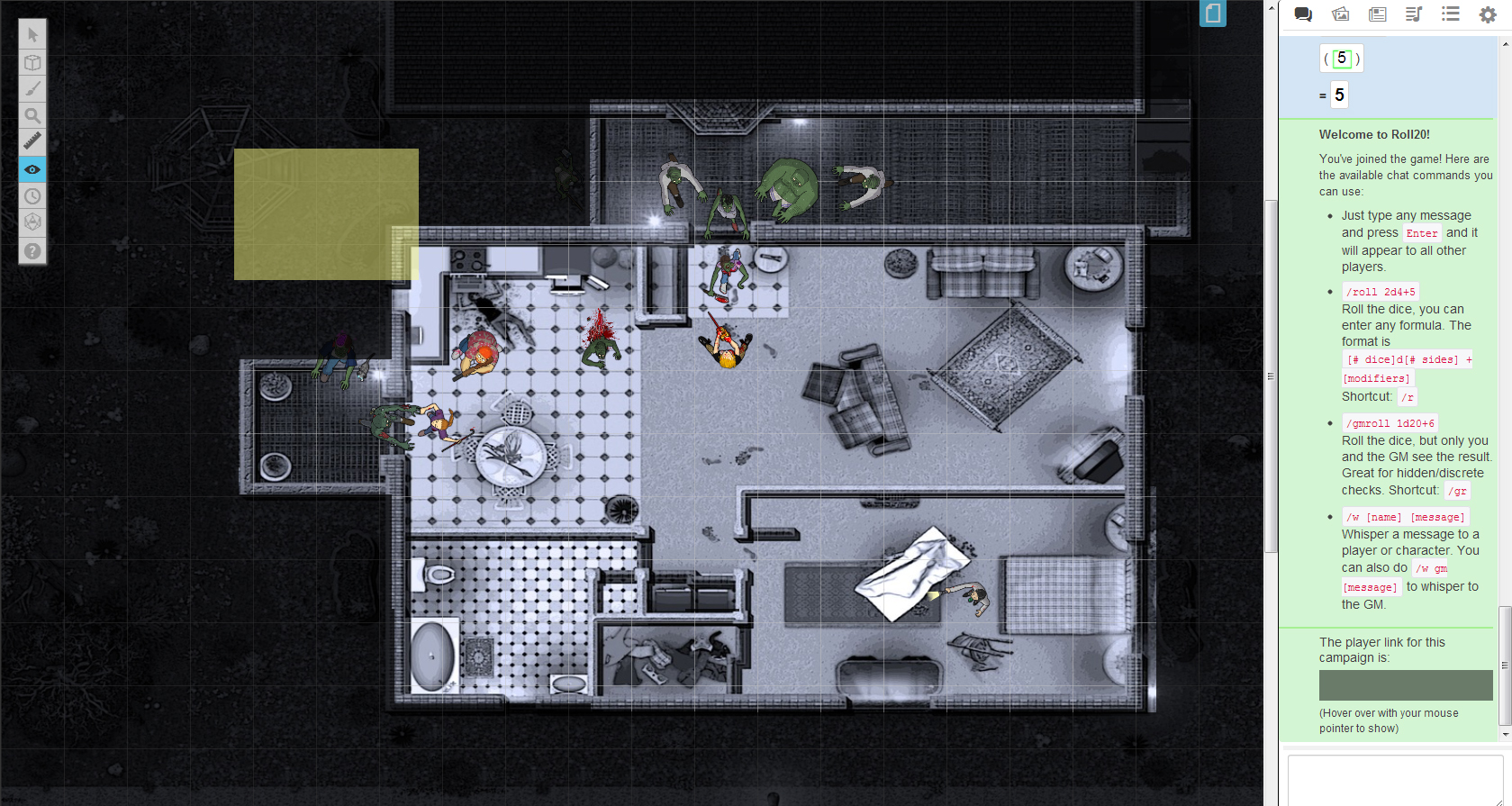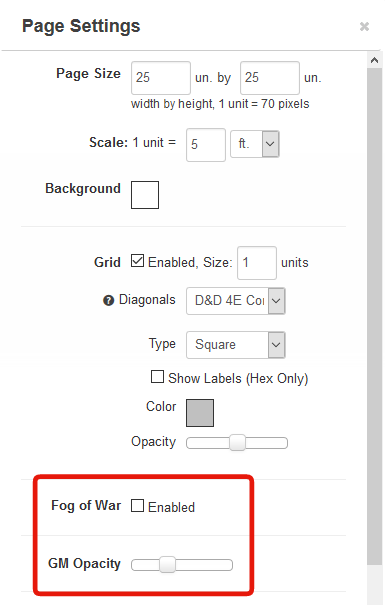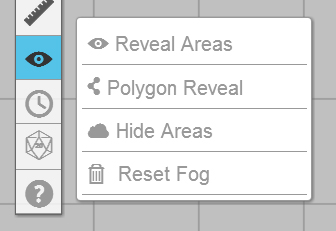Difference between revisions of "Fog of War"
From Roll20 Wiki
Andreas J. (Talk | contribs) (add icons, toolbar section) |
|||
| Line 1: | Line 1: | ||
<div style="background:#f0e2a1; border: 3px solid #dbc870; padding: 10px;"> | <div style="background:#f0e2a1; border: 3px solid #dbc870; padding: 10px;"> | ||
<big>'''''Attention:''''' | <big>'''''Attention:''''' | ||
| − | ''Roll20 is no longer maintaining this document on the community wiki. For the most up-to-date information please visit this page on our | + | ''Roll20 is no longer maintaining this document on the community wiki. For the most up-to-date information please visit this page on our help center for assistance: [https://roll20.zendesk.com/hc/en-us/articles/360037774513-Fog-of-War Here].''</big> |
</div> | </div> | ||
[[File:FogofWar.jpg|550px|thumb|Fog of War in Action]] | [[File:FogofWar.jpg|550px|thumb|Fog of War in Action]] | ||
Revision as of 18:13, 15 May 2020
Attention: Roll20 is no longer maintaining this document on the community wiki. For the most up-to-date information please visit this page on our help center for assistance: Here.
| For the Plus/Pro Subscription feature, see Advanced Fog of War |
Contents |
The Fog of War Feature
The Fog of War feature allows you to gradually reveal areas of the map to your players. This is useful if you have a party exploring a dungeon where they shouldn't be able to see the rooms and hallways that have yet to be seen. Fog of War is static and can only be removed or covered up again manually by the GM; the presence or absence of PCs, light sources, lines of sight, etc. will not roll back any Fog of War. Roll20 paid subscriber's have access to Dynamic Lighting which is an additional tool that offers a dynamic and hands-off means to track line of sight and player vision on a Page.
The Fog of War will cover up anything on the tabletop, including all tokens, maps, text, and drawings. The only exception is that a player can see any token that he or she has control over. This prevents players from accidentally moving their tokens into a location beneath the fog where only the GM could recover them.
Enabling Fog of War
By default, a page has their Fog of War feature disabled. To enable, go to the Page Toolbar, and then click the gear icon for the page you wish to add Fog of War to. The gear icon will open that page's Page Settings window. Check the checkbox next to Fog of War: Enabled to activate the Fog of War. Click on the OK button at the bottom of the Page Settings window to save your changes. If you have the edited page currently loaded on the Tabletop, your view of the Tabletop will now appear slightly darker. This is the Fog of War added to the Page. Once enabled, the entire page will be hidden behind the Fog of War and ready for the GM to start revealing areas of the map for the players.
In the Page Settings window you can also adjust the GM Opacity slider. This controls how dark the Fog of War and Dynamic Lighting appears to the GM. Slide it to the right for greater opacity. At 100%, the Fog of War will be completely opaque, I.e. solid black, to the GM just as it would be for your players. If you are a PLUS or PRO subscriber, your GM Opacity slider will be listed after the Dynamic Lighting settings of the Page Settings window.
Revealing/Hiding Areas
Clicking on the Eye icon of the Tabletop Toolbox will pull up a submenu of Fog of War tools to reveal or hide areas of the page.E Reveal Areas Tool
When using Reveal Areas, left click and drag on the Tabletop to draw out a rectangle. You will see a yellow selection area appear under your mouse cursor as you do this. When you release the mouse button, the area you have drawn will be revealed. To reveal further parts of the page, just repeat this process.
c Polygon Reveal Tool
The Polygon Reveal tool functions the same way one would use the Polygon/Line Tool from the Drawing menu of the Tabletop Toolbox. Click on the Tabletop where you want the vertices of the polygon to be drawn and a yellow selection area will start taking shape. Hold down the Shift key while drawing to conform the polygon vertices to the grid. Pressing CTRL/Option + Z while drawing will undo the last vertex step you made. Either hit the Escape key, right click, or left click close to the starting point of the polygon to finish the shape.
C Hide Areas Tool
If you've made a mistake or need to cover a previously revealed area of the page with fog, choose the Hide Areas subtool. This tool operated exactly like the Reveal Areas subtool. Each rectangular area you click and drag over the Tabletop will cover that area with fog again.
# Reset Fog
If you would like to cover the Tabletop completely up with Fog again, select the Reset Fog subtool. A confirmation window will appear first to ensure that this action isn't made by mistake.
Previewing Your Work
If you wish to see what your Fog of War masking looks like from the Player's side, go to the Settings Tab on the Sidebar and at the top of the tab, click on the Re-Join as Player button. This will reload Roll20 with the Player's user interface. To jump back to GM Mode, go back to the Settings Tab and click on the Re-Join as GM button.
| NOTE: Make sure you've set the Players Bookmark Ribbon on the page you're currently working on or else your Tabletop might load an undesired page. |
This can also be achieved by going back to the Page Settings and sliding the GM Opacity to 100%, but you may find the above method faster.
See Also
- Advanced Fog of War the Plus/Pro version of the feature
- Dynamic Lighting Plus/Pro feature
- Page Toolbar
- Toolbox(sidebar)
- w Select and Pan Tool
- b Layers
- i Drawing Tools
- e FX Tool
- s Zoom Tool
-
 Ruler Tool
Ruler Tool
- E Fog of War
- t Turn Tracker
- t Dice Rolling GUI
- ? Help Tool












